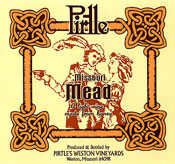 We started the second day on our Monticello Wine Tour at Blenheim Vineyards, the domain of the Matthews family: Peter, Kathleen, and Dave. The winery is located in historic Blenheim, an area first granted in 1730 to the John Carter - the Secretary of the Colony of Virginia. Different properties were built and inhabited on the property - with the oldest being the Claims House - built in the 1730's. In 2000 Dave and Peter Matthews, along with partner and winemaker Brad McCarthy planted vines in order to create a winery on the site. The goal was to create a new style of wines, free from oak, the McCarthy saw on a regular basis as a winemaker in California. The winery operated privately for the next eight years with Peter managing the vines and Brad producing the wine. The winery was open by appointment only - so the wines were sold in neighboring retail outlets - basically by word of mouth. In 2007 McCarthy left, leaving Peter as the Directory of Operations. In June 2008 he hired Kirsty Harmon as the new winemaker and that is who greeted us on our arrival.
We started the second day on our Monticello Wine Tour at Blenheim Vineyards, the domain of the Matthews family: Peter, Kathleen, and Dave. The winery is located in historic Blenheim, an area first granted in 1730 to the John Carter - the Secretary of the Colony of Virginia. Different properties were built and inhabited on the property - with the oldest being the Claims House - built in the 1730's. In 2000 Dave and Peter Matthews, along with partner and winemaker Brad McCarthy planted vines in order to create a winery on the site. The goal was to create a new style of wines, free from oak, the McCarthy saw on a regular basis as a winemaker in California. The winery operated privately for the next eight years with Peter managing the vines and Brad producing the wine. The winery was open by appointment only - so the wines were sold in neighboring retail outlets - basically by word of mouth. In 2007 McCarthy left, leaving Peter as the Directory of Operations. In June 2008 he hired Kirsty Harmon as the new winemaker and that is who greeted us on our arrival.The winery building itself is a fascinating structure. It's enormity is hidden as the entrance is located on the down side of a hill - and the actual operations located beneath the slope - think of a walk out basement below a house. The fermenting and aging operations can be viewed from the tasting area through glass floors that run the length of the facility. The steeple ceiling and skylights provide character - and apparently no lights are required to brighten the tasting area during the summer. Looking out the back, Blenheim's vineyards spread out on the left, while neighboring Kluge Estate's vines are seen directly in the distance. This is a great location to hang out; and open area with excellent views. Our party of 12 comfortably settled into a long wooden table - ready to try the wines made from Ms. Harmon's predecessor.
The winery currently offers three Chardonnay brands, the Star label, Ox-Eye, and Blenheim Farm. Of the three the two vineyard specific wines were the best - the Ox-Eye grown near Stanton, the Blenheim Farm on the estate. The Ox-Eye had an interesting hazelnut tone whereas the Blenheim Farm was more acidic and refreshing. For reds, Blenheim currently offers a Cabernet Franc, Meritage blend, and Petit Verdot. The Cabernet Franc was decent - nothing special, whereas the Meritage was a very good ever day drinking wine. It's lighter than most Bordeaux styled blends but has a nice cherry flavor. Plus its marked down to $10 in order to move inventory. Finally, the Petit Verdot was the full bodied red offering - made from estate grown grapes. It has some blackberry flavors and with enough tannins to encourage aging. It was a little awkward having Ms. Harmon describe wines she did not produce - so we headed into the fermenting area to sample her products.
Blenheim's new winemaker took an interesting route to that position. She graduated from the University of Virginia in 1998 with a degree in biology and work with yeast strains for a number of years. Over time she developed an appreciation for wine and apprenticed with local winemaker Gabriele Rausse (look forward to our posting on Jefferson Vineyards to learn more about Rausse). Eventually she attended UC-Davis and in 2007 graduated with an M.S. in Viticulture and Enology. After graduation and pre-Blenheim she worked in France and in New Zealand honing her skills. Back to Blenheim we started with Viognier aging in steel - the wine was already crisp and fruity and look for bottling sometime in April. We moved to the barrels and sampled some free run Cabernet Franc and a more tannic version - with the fruit forward wine ready to drink now. She will eventually blend the two after determining the precise balance of fruit and tannin. The biggest surprise was Cabernet Sauvignon aging in a barrel. In general we are not fans of Virginia made Cabernet Sauvignon, but this version has potential. It actually had body and texture and should make a wine worth aging. We will look forward to this one as well as her Petit Verdot - which we realized is Virginia's nest hope for red wine.
 |  |  |
























